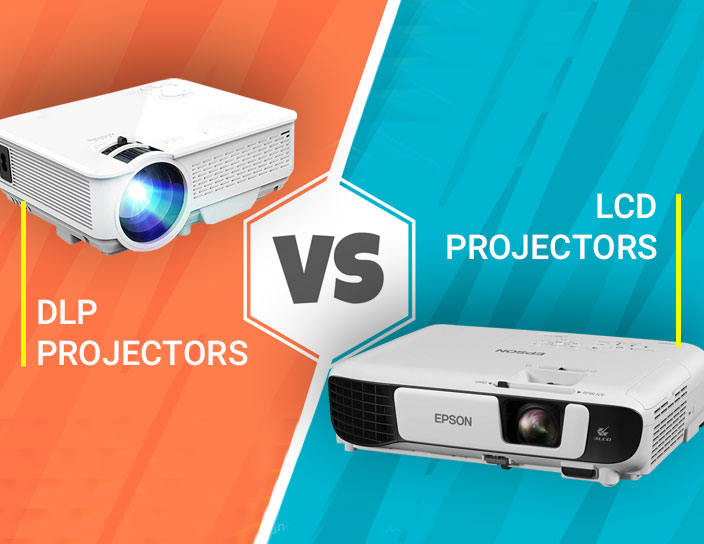
Be it for giving project overview in college or demonstrating plans and visions at office conferences, we often need projectors to showcase everything clearly and impactfully. The scope of a projector does not quite end there. Some projectors are also used as home theatres and in recent days, projectors are becoming extremely popular in live streaming at grand events with a huge mass of people. So, for the portability and widespread use, the need for projectors is growing at a rapid pace.
Since projectors are getting so popular, we thought of providing some important information which will help you in deciding which projector best suits your specific requirements.
To begin with, let’s look a little closer at what the names themselves mean. DLP is an abbreviation for Digital Light Processing and LCD stands for Liquid Crystal Display. The differences between the technologies however, go a lot deeper than that.
LCD vs DLP - The Technologies
DLP projectors use a digital mirror device which is also called a DLP chip. There are two kinds of DLP projectors - single-chip DLPs and 3 chip DLPs. The major advantage of DLP technology is that its chip is sealed which means that the projectors have no filters inside them. When it comes to size, single-chip DLP projectors are the smallest projectors.
LCD technology on the other hand, is the more established technology which was implemented in projectors for the very first time. LCD projectors use a liquid crystal chip inside the projector which produce all the colours. The LCD microdisplays are transmissive in which light must pass through from the back of the display panel. This is similar to the LCD flat-panel televisions which either use LED or fluorescent backlight located behind their transmissive display panels.
LCD vs DLP - The Images
The downside of the DLP technology is that it shows a lesser vivid picture when brand new as compared to LCD projectors.
One of the pros of this technology is it produces the most vivid colours and the quality of the picture is very high. Today, all projectors with LCD technology use 3 LCD microdisplay chips with one for each of the three primary colours – Red, Green, and Blue. These are often referred to as 3 LCD projectors.

In the past, LCD based projectors suffered from higher black levels and a lower contrast ratio as compared to the DLP projectors. However, significant improvements both in LCD projection technology and techniques like dynamic irises in recent years has resulted in great performance levels. The downside of this technology is that the brightness and colours start deteriorating over time.

LCD vs DLP - The Applications
Single-chip DLP projectors make up most of the DLP projectors used for businesses, education, and home theatres. 3 chip DLP projectors are available for high-end home theatres and commercial applications including digital cinema projectors.
LCD vs DLP - Cost and ROI
Single-chip DLP projectors have remained popular over the past decade and are generally known for offering good performance at a competitive price. Even if you replace the lamp module in 2-3 years, the image and brightness of the image remain the same.Now, that is a big advantage for many people.
A few more things to consider
Before buying any projector, you must take into consideration how many hours you are going to use the projector. If you are planning to use the projector for 3-5 hours per week, you are not going to notice any deterioration in any of the projectors for at least 2000-3000 hours. Because the technology in both LCD and DLP is good enough to ensure that neither manufacturer nor technology is going to notice significant drop-offs for a reasonable period. If, however, you are going to use the projector for 30 hours per week then you are going to hit that 3000-hour figure within 18 months to 2 years.
Also, do consider your space, ambience, lighting conditions, applications, and budget before buying a projector.
You can connect with Ooberpad experts for assistance in deciding which projector is the best fit for you.
Comparison Table
| Parameters | DLP | LCD |
| Working Principal | Comprises a chip with a reflective surface having 1,000s of tiny mirrors coordinated with a light source for reflecting digital imagery to any surface. | Light is projected onto mirrors and split into 3 primary colors: red, green and blue. Colors then pass via 3 separate prisms, with colors converged via 2nd prism for projection on screen. |
| Advantages | -Smoother video -Smaller box -Pixels less visible -Filmlike vision on HDTV -Generate blacker blacks -Higher contrast -Portable |
-Richer color dynamics in --Ambient light -Less power -Throw less heat -No rainbow effects -Quieter -Sharper image on data |
| Drawbacks | Some rainbows effect More moving parts Produce audible whine Poorer reds, yellows at full power Color saturation More lumens than LCD with ambient light |
More visible pixels Some screen door effect on certain video images Larger - even for same lumen Poorer contrast Black is lighter gray than in DL |
| Image Quality | Good picture quality, but poorer than LCD projectors | Sharper image; better picture quality than DLP projectors |
| Contrast | Higher than LCD | Lower than DLP |
| Portability | Smaller, Lighter, Easily portable | Bulkier, Not very convenient for portability |
| Light Source | LED or Standard Lamp | Standard Lamp |
| Technology Type | Reflective | Transmissive |
| Year of invention | 1987 | 1968 |
| Rainbow Effect | Yes | No |









